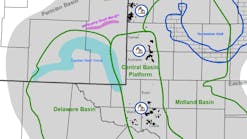US oil producers operating in the Eagle Ford shale in South Texas built an inventory of nearly 1,400 drilled but uncompleted (DUC) wells, said an analysis from IHS, which noted that the most promising of these wells belong to a few operators.
The IHS Energy Analysis of Drilled, but Uncompleted Wells in the Eagle Ford Shale indicates DUCs can be converted to producing assets for 65% of the cost of a new drill, significantly lowering the economics when evaluated against remaining costs.
Nearly 40% of the 1,400 DUCs are considered to have break-even costs below $30/bbl and belong to a few operators, including BHP Billiton, Chesapeake Energy Corp., Anadarko Petroleum Corp., EOG Resources Inc., ConocoPhillips, and Pioneer Natural Resources Co. Meanwhile, 33 other operators account for the rest of the Eagle Ford DUCs.
“In this low oil-price environment, operators in the Eagle Ford and other US shale plays are focused on optimizing the value of their assets and managing their costs, and these drilled but uncompleted wells enable them to do that more effectively for several reasons,” said Raoul LeBlanc, senior director of research at IHS Energy, and the lead author of the DUC analysis.
“First, the drilling costs of these wells were already incurred by operators prior to 2015, and the completion costs—which comprise the majority of well costs—can be negotiated at a cheaper rate since completion crews are now both available and available at cheaper rates,” LeBlanc said. “Second, if completion costs are fairly consistent in the play, then it stands to reason that wells with higher production will yield better returns on capital.”
The DUC inventory is driven by the drilling sector outpacing the completion industry, the IHS analysis noted. As the rate of new wells drilled in the play falls, completion crews will be able to convert more wells to alleviate the DUC backlog.
The DUC inventory is comprised of wells with varying production expectations. Given differences among companies, the pace of DUC conversions will vary by operator.
“The more desirable DUC wells are located in the northeast core sub-region of the Eagle Ford shale play, so operators such as EOG Resources, BHP Billiton, and ConocoPhillips have significant financial flexibility and greater options,” said Robert Fryklund, chief upstream strategist at IHS Energy and a co-author of the DUC analysis.
He also noted that some operators who complete lower-productivity DUCs in the Eagle Ford west area might delay completions until oil prices rebound, Fryklund said.
He believes the Eagle Ford DUC wedge production alone could generate an additional 180,000 b/d of oil in the second half, which would be 14% of the play’s production of 1.25 million b/d/year.
“This further supports our IHS view that oil price fundamentals will face headwinds despite the collapsing rig count, and that a material price increase could lead to a supply response in late 2015 and 2016,” Fryklund said.
Contact Paula Dittrick at [email protected].
*Paula Dittrick is editor of OGJ’s Unconventional Oil & Gas Report.

Paula Dittrick | Senior Staff Writer
Paula Dittrick has covered oil and gas from Houston for more than 20 years. Starting in May 2007, she developed a health, safety, and environment beat for Oil & Gas Journal. Dittrick is familiar with the industry’s financial aspects. She also monitors issues associated with carbon sequestration and renewable energy.
Dittrick joined OGJ in February 2001. Previously, she worked for Dow Jones and United Press International. She began writing about oil and gas as UPI’s West Texas bureau chief during the 1980s. She earned a Bachelor’s of Science degree in journalism from the University of Nebraska in 1974.
